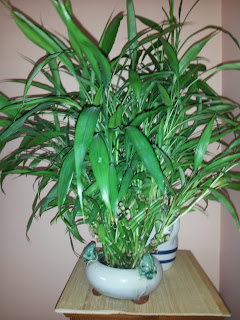 |
| Lucky Bamboo Plants |
One of the best ways to clean the indoor air of your home or office is with a houseplant or two in each of your rooms or on your desk. The more plants you have, the better the indoor quality of your air. This is because plants absorb carbon dioxide and other toxins and release oxygen into the surrounding air during photosynthesis.
 A study done by (NASA, Wolverton, 1989), proved the capabilities of several varieties of plants in removing, formaldehyde, benzene, and other toxins or volatile organic compounds (VOCs) from our living environment. In fact, many of these plants are so beneficial at reducing VOCs they are targeted for future space missions. For example, the Peace Lily and the Pot Mum remove all of the toxic chemicals in the study: benzene, formaldehyde, trichloroethylene, xylene, toluene, and ammonia. Golden Potho's, Mother-in-Law's Tongue, and the Red-edged Dracaena remove all but ammonia. The popular Bamboo or Reed Palm, better known as Lucky Bamboo as shown in the photo above, removes formaldehyde, xylene, and toluene. Perhaps it is lucky after all. That doesn't mean you have to turn your home or office into a jungle. Studies have shown that just one six inch plant per every 100 square feet will suffice. Broad leafed plants seem to perform the best. We inadvertently introduce these toxins into our indoor environments when we remodel, redecorate, and clean our homes and offices. New carpet and furnishings, wood stains, polyurethane coatings, paints and cleaners all contribute to the indoor pollution of buildings. Add to this the dust containing germs, dust mites, pollens and other irritants, it's no wonder many people become ill when confined to a building for long periods of time. This indoor air pollution is now attributed to Sick Building Syndrome or SBS. You can view a more detailed chart at (Wilkepedia, 2013) where it lists specific chemicals removed as well as toxicities to children and pets for a greater number of houseplants. Reducing at least some of these toxins contributes to a more healthy indoor environment. Some of the more common and easy to grow house plants for reducing toxins, as well as removing carbon dioxide (CO2) from the air, according to the study above, are listed below:
A study done by (NASA, Wolverton, 1989), proved the capabilities of several varieties of plants in removing, formaldehyde, benzene, and other toxins or volatile organic compounds (VOCs) from our living environment. In fact, many of these plants are so beneficial at reducing VOCs they are targeted for future space missions. For example, the Peace Lily and the Pot Mum remove all of the toxic chemicals in the study: benzene, formaldehyde, trichloroethylene, xylene, toluene, and ammonia. Golden Potho's, Mother-in-Law's Tongue, and the Red-edged Dracaena remove all but ammonia. The popular Bamboo or Reed Palm, better known as Lucky Bamboo as shown in the photo above, removes formaldehyde, xylene, and toluene. Perhaps it is lucky after all. That doesn't mean you have to turn your home or office into a jungle. Studies have shown that just one six inch plant per every 100 square feet will suffice. Broad leafed plants seem to perform the best. We inadvertently introduce these toxins into our indoor environments when we remodel, redecorate, and clean our homes and offices. New carpet and furnishings, wood stains, polyurethane coatings, paints and cleaners all contribute to the indoor pollution of buildings. Add to this the dust containing germs, dust mites, pollens and other irritants, it's no wonder many people become ill when confined to a building for long periods of time. This indoor air pollution is now attributed to Sick Building Syndrome or SBS. You can view a more detailed chart at (Wilkepedia, 2013) where it lists specific chemicals removed as well as toxicities to children and pets for a greater number of houseplants. Reducing at least some of these toxins contributes to a more healthy indoor environment. Some of the more common and easy to grow house plants for reducing toxins, as well as removing carbon dioxide (CO2) from the air, according to the study above, are listed below:Bamboo Palm-Chamaedorea Seifritzii
English Ivy-Hedera Helix
Gerbera Daisy-Gerbera Jamesonii
Pot Mum-Chrysanthemum Morifdium
Boston Fern-Nephrolepis Exaltata
Spider Plant-Chlorophytum Comosum
Dumb Cane (Camilla or Exotica)-Dieffenbachia
Mother-in-Law's Tongue-Sanseviria Laurentii
Peace Lily(Mauna Loa)-Spathiphyllum
Red-edged Dracaena-Dracaena Marginata
Golden Pothos-Scindapsus Aures or
Epipremnum Aureum
Heartleaf Philodendron-Philodendron
Oxycardium, syn. Philodendron Cordatum
 The lavender plant is a wonderful addition to this list for its duo purpose qualities. Lavender is known for cleaning the air, while also inducing a state of relaxation due to the chemical composition of its scent. Both attributes important for those with allergies as well as asthmatics. Obviously, cleaning the air reduces allergy and asthma symptoms on a physical level, but stress reduction is also important for relieving allergy and asthma symptoms. When your body is stressed it releases hormones and histamines. Eventually, if the stress is not reduced, your immune system wears down and symptoms become worse. Before you know it, you're repeating a vicious cycle of symptoms, medications, and anxiety. So growing an indoor lavender plant can have many benefits. Lavender requires a bright sunny location to flower and flourish indoors. Lavender would also be beneficial in the stressful environment of a sunny office. It must be allowed to dry out slightly between thorough waterings. You'll know when to water when it begins to droop. Be sure to drain it completely to avoid root rot. If your home or office is very dry, you can place it on a tray filled with water and pebbles, gravel, or sand to provide humidity.
The lavender plant is a wonderful addition to this list for its duo purpose qualities. Lavender is known for cleaning the air, while also inducing a state of relaxation due to the chemical composition of its scent. Both attributes important for those with allergies as well as asthmatics. Obviously, cleaning the air reduces allergy and asthma symptoms on a physical level, but stress reduction is also important for relieving allergy and asthma symptoms. When your body is stressed it releases hormones and histamines. Eventually, if the stress is not reduced, your immune system wears down and symptoms become worse. Before you know it, you're repeating a vicious cycle of symptoms, medications, and anxiety. So growing an indoor lavender plant can have many benefits. Lavender requires a bright sunny location to flower and flourish indoors. Lavender would also be beneficial in the stressful environment of a sunny office. It must be allowed to dry out slightly between thorough waterings. You'll know when to water when it begins to droop. Be sure to drain it completely to avoid root rot. If your home or office is very dry, you can place it on a tray filled with water and pebbles, gravel, or sand to provide humidity.If your allergies or asthma are attributed to mold, you can water the plant from the bottom with a tray to prevent the top layer of soil from getting too moist, or just cover the top of the soil with gravel to prevent mold spores escaping into the air. Annual repotting with sterile soil also helps to alleviate mold growth. Add to this soil a thin layer of activated charcoal to help capture the chemicals absorbed by the plant into the root system. Eventually the chemicals will be broken down by microbes. Lucky Bamboo is also a good plant for those with mold sensitivities, because it is easily grown in water. Frequent water changes prevent the growth and spread of mold spores. Another option is hydroponics, a growing method that's uses no soil. If you would like to try your hand at that method here is a small kit to get you started:
Note: Lavender has been found to be an allergen in some people, although, it is extremely rare.
Just be aware that if your breathing problem worsens or other symptoms develop; you
could be one of those rare persons allergic to lavender, and you should discontinue its use.
HAPPY BREATHING!!!
Sources:Wolverton, B. C. et al (1989), NASA "Interior Landscape Plants for Indoor Air Pollution Abatement."
List of air-filtering plants. (2013, February 27). In Wilkepedia, The Free Encyclopedia. Retrieved 14:14 March 16, 2013, from




No comments:
Post a Comment
Please feel free to ask any questions you might have, or share other tips and tricks for combating allergies, asthma, and toxins in our environment with other readers.